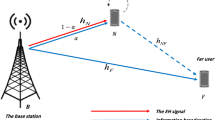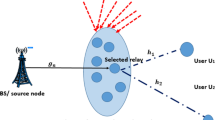Abstract
This paper investigates a novel full-duplex (FD) simultaneous wireless information and power transfer (SWIPT) based cooperative non-orthogonal multiple access (FDS-NOMA) system, where far distant NOMA IoT users are helped by the NOMA strong user with the capability of energy harvesting (EH) and FD communications. The downlink (DL-NOMA) principle is used to transmit the superimposed signals from source i.e a base station (BS) to an energy-limited FD relay where relay harvests energy from the transmit power of the BS. The relay after detecting the superimposed signals using successive interference cancellation (SIC), retransmits the decoded signals using superposition coding to the IoT users. We derive the analytical expressions of the outage probability and ergodic rates experienced by the NOMA strong user as well as NOMA IoT users. The results shows that proposed cooperative NOMA scheme can be used to serve IoT users using EH relay. Extensive simulations are performed to verify the accuracy of the derived approximate closed-from expressions.










Similar content being viewed by others
Notes
U2 and U3 are considered as IoT nodes.
References
Dai, L., Wang, B., Ding, Z., Wang, Z., Chen, S., & Hanzo, L. (2018). A survey of non-orthogonal multiple sccess for 5G. IEEE Communications Surveys and Tutorials, 20(3), 2294–2323. https://doi.org/10.1109/COMST.2018.2835558
Wunder, G., et al. (2014). 5GNOW: Non-orthogonal, asynchronous waveforms for future mobile applications. IEEE Communications Magazine, 52(2), 97–105. https://doi.org/10.1109/MCOM.2014.6736749
Saito, Y., Kishiyama, Y., Benjebbour, A., Nakamura, T., Li, A., & Higuchi, K. (2013). Higuchi non-orthogonal multiple access (NOMA) for cellular future radio access, In 2013 IEEE 77th vehicular technology conference (VTC Spring).
Ding, Z., Liu, Y., Choi, J., Sun, Q., Elkashlan, M., Chih-Lin, I., & Poor, H. V. (2017). Application of non-orthogonal multiple access in LTE and 5G networks. IEEE Communications Magazine, 55(2), 185–191. https://doi.org/10.1109/MCOM.2017.1500657
Wei, Z., Yuan, J., Ng, D. W. K., Elkashlan, M., Ding, Z. (2016). A survey of downlink non-orthogonal multiple access for 5G wireless communication networks. Available: arxiv:1609.0186.
Dang, H., Van Nguyen, M., Do, D., Pham, H., Selim, B., & Kaddoum, G. (2020). Joint relay selection, full-duplex and device-to-device transmission in wireless powered NOMA networks. IEEE Access, 8, 82442–82460. https://doi.org/10.1109/ACCESS.2020.2991847
Rauniyar, A., Engelstad, P., Ësterb, O. N. (2018). RF energy harvesting and information transmission based on power splitting and NOMA for IoT Relay Systems, in 2018 IEEE 17th international symposium on network computing and applications (NCA), pp. 1–8, https://doi.org/10.1109/NCA.2018.8548068.
Do, D.-T., Le, C.-B., & Afghah, F. (2020). Enabling full-duplex and energy harvesting in uplink and downlink of small-cell network relying on power domain based multiple access. IEEE Access, 8, 142772–142784. https://doi.org/10.1109/ACCESS.2020.3013912
Ding, Z., Lei, X., Karagiannidis, G. K., Schober, R., Yuan, J., & Bhargava, V. K. (2017). A survey on non-orthogonal multiple access for 5G networks: Research challenges and future trends. IEEE Journal on Selected Areas in Communications, 35(10), 2181–2195. https://doi.org/10.1109/JSAC.2017.2725519
Wu, Q., Chen, W., Ng, D. W. K., & Schober, R. (2018). Spectral and energy-efficient wireless powered iot networks: NOMA or TDMA? IEEE Transactions on Vehicular Technology, 67(7), 6663–6667. https://doi.org/10.1109/TVT.2018.2799947
Zeng, M., Yadav, A., Dobre, O. A., & Poor, H. V. (2017). A fair individual rate comparison between MIMO-NOMA and MIMO-OMA. IEEE Globecom Workshops (GC Wkshps), 2017, 1–5. https://doi.org/10.1109/GLOCOMW.2017.8269085
Timotheou, S., & Krikidis, I. (2015). Fairness for non-orthogonal multiple access in 5G systems. IEEE Signal Processing Letters, 22(10), 1647–1651. https://doi.org/10.1109/LSP.2015.2417119
Huang, K., & Lau, V. K. N. (2012). Enabling wireless power transfer in cellular networks: Architecture modeling and deployment. EEE Journal on Selected Areas in Communications, 13(2), 902–912.
Varshney, L. R. (2008). Transporting information and energy simultaneously. IEEE International Symposium on Information Theory, 2008, 1612–1616. https://doi.org/10.1109/ISIT.2008.4595260
Grover, P., & Sahai, A. (2010). Shannon meets Tesla: Wireless information and power transfer. IEEE International Symposium on Information Theory, 2010, 2363–2367. https://doi.org/10.1109/ISIT.2010.5513714
Fouladgar, A. M., & Simeone, O. (2012). On the transfer of information and energy in multi-user systems. IEEE Communications Letters, 16(11), 1733–1736. https://doi.org/10.1109/LCOMM.2012.091212.121660
Ding, Z., Peng, M., & Poor, H. V. (2015). Cooperative non-orthogonal multiple access in 5G systems. IEEE Communications Letters, 19(8), 1462–1465. https://doi.org/10.1109/LCOMM.2015.2441064
Men, J., & Ge, J. (2015). Non-orthogonal multiple access for multiple-antenna relaying networks. IEEE Communications Letters, 19(10), 1686–1689. https://doi.org/10.1109/LCOMM.2015.2472006
Liu, Y., Ding, Z., Elkashlan, M., & Poor, H. V. (2016). Cooperative non-orthogonal multiple access with simultaneous wireless information and power transfer. IEEE Journal on Selected Areas in Communications, 34(4), 938–953. https://doi.org/10.1109/JSAC.2016.2549378
Zhang, Z., Ma, Z., Xiao, M., Ding, Z., & Fan, P. (2017). Full-duplex device-to-device-aided cooperative non-orthogonal multiple access. IEEE Transactions on Vehicular Technology, 66(5), 4467–4471. https://doi.org/10.1109/TVT.2016.2600102
Zhou, X., Zhang, R., & Ho, C. K. (2013). Wireless information and power transfer: Architecture design and rate-energy tradeoff. IEEE Transactions on Communications, 61(11), 4754–4767. https://doi.org/10.1109/TCOMM.2013.13.120855
Guo, C., Zhao, L., Feng, C., Ding, Z., & Chen, H. (2019). Energy harvesting enabled NOMA systems with full-duplex relaying. IEEE Transactions on Vehicular Technology, 68(7), 7179–7183. https://doi.org/10.1109/TVT.2019.2914508
Nguyen, B. C., et al. (2020). Outage probability of NOMA system with wireless power transfer at source and full-duplex relay. AEU-International Journal of Electronics and Communications, 116, 152957.
Hoang, T. M., Nguyen, B. C., & Trung, T. T. (2020). Outage and throughput analysis of power-beacon assisted nonlinear energy harvesting NOMA multi-user relay system over Nakagami-m fading channels. Heliyon, 6(11), e05440.
Nguyen, T.-T., Nguyen, S. Q., Nguyen, P. X., & Kim, Y.-H. (2022). Evaluation of full-duplex SWIPT cooperative NOMA-based IoT relay networks over Nakagami-m fading channels. Sensors, 22(5), 1974. https://doi.org/10.3390/s22051974
Vu, T.-H., Nguyen, T.-V., & Kim, S. (2022). Cooperative NOMA-enabled SWIPT IoT networks with imperfect SIC: Performance analysis and deep learning evaluation. IEEE Internet of Things Journal, 9(3), 2253–2266. https://doi.org/10.1109/JIOT.2021.3091208
Nguyen, T.-T., Nguyen, V.-D., Pham, Q.-V., Lee, J.-H., & Kim, Y.-H. (2021). Resource allocation for AF relaying wireless-powered networks with nonlinear energy harvester. IEEE Communications Letters, 25(1), 229–233. https://doi.org/10.1109/LCOMM.2020.3023937
Wu, W., Yin, X., Deng, P., Guo, T., & Wang, B. (2019). Transceiver design for downlink SWIPT NOMA systems with cooperative full-duplex relaying. IEEE Access, 7, 33464–33472.
Bisen, S., Shaik, P., & Bhatia, V. (2021). On Performance of Energy Harvested cooperative NOMA under imperfect CSI and imperfect SIC. IEEE Transactions on Vehicular Technology, 70(9), 8993–9005. https://doi.org/10.1109/TVT.2021.3099067
Nguyen, B. C., et al. (2020). Outage probability of NOMA system with wireless power transfer at source and full-duplex relay. AEU-international Journal of Electronics and Communications, 116, 152957.
Manh Hoang, T., Nguyen, B. C., Trung, T. T., & Dung, L. T. (2020). Outage and throughput analysis of power-beacon assisted nonlinear energy harvesting NOMA multi-user relay system over Nakagami-m fading channels. Heliyon., 6(11), e05440. https://doi.org/10.1016/j.heliyon.2020.e05440
Nguyen, B. C., et al. (2019). Performance analysis of energy harvesting-based full-duplex decode-and-forward vehicle-to-vehicle relay networks with nonorthogonal multiple access. Wireless Communications and Mobile Computing, 2019, 1–11.
Vu, T.-H., Nguyen, T.-V., & Kim, S. (2022). Cooperative NOMA-Enabled SWIPT IoT Networks With Imperfect SIC: Performance Analysis and Deep Learning Evaluation. IEEE Internet of Things Journal, 9(3), 2253–2266. https://doi.org/10.1109/JIOT.2021.3091208
Nguyen, T. T., Nguyen, V. D., Pham, Q. V., Lee, J. H., & Kim, Y. H. (2020). Resource allocation for AF relaying wireless-powered networks with nonlinear energy harvester. IEEE Communications Letters, 25(1), 229–233. https://doi.org/10.1109/LCOMM.2020.3023937
Parihar, A. S., Swami, P., Bhatia, V., & Ding, Z. (2021). Performance analysis of SWIPT enabled cooperative-NOMA in heterogeneous networks using carrier sensing. IEEE Transactions on Vehicular Technology, 70(10), 10646–10656. https://doi.org/10.1109/TVT.2021.3110806
Singh, S. K., Agrawal, K., Singh, K., Li, C.-P., & Alouini, M.-S. (2022). NOMA enhanced UAV-assisted communication system with nonlinear energy harvesting. IEEE Open Journal of the Communications Society, 3, 936–957. https://doi.org/10.1109/OJCOMS.2022.3178147
Bharadia, D., & McMilin, E., Katti, S. (2013). Full duplex radios. In Proceedings of the ACM SIGCOMM 2013 Conference on SIGCOMM (SIGCOMM’13), Hong Kong, China, 12–16; pp. 375–386.
Zhang, Z., Ma, Z., Xiao, M., Ding, Z., & Fan, P. (2017). Full-duplex device-to-device-aided cooperative non-orthogonal multiple access. IEEE Transactions on Vehicular Technology, 66, 4467–4471.
Xu, B., Xiang, Z., Ren, P., & Guo, X. (2021). Outage performance of downlink full-duplex network-coded cooperative NOMA. IEEE Wireless Communications Letters, 10, 26–29.
Ma, L., Li, E., & Yang, Q. (2021). On the performance of full-duplex cooperative NOMA with non-linear EH. IEEE Access, 9, 145968–145976. https://doi.org/10.1109/ACCESS.2021.3124090
Aswathi, V., & Babu, A. V. (2021). Outage and throughput analysis of full-duplex cooperative NOMA system with energy harvesting. IEEE Transactions on Vehicular Technology, 70(11), 11648–11664. https://doi.org/10.1109/TVT.2021.3112596
Zhang, Z., Ma, Z., Xiao, M., Ding, Z., & Fan, P. (2017). Full-duplex device-to-device-aided cooperative non orthogonal multiple access. IEEE Transactions on Vehicular Technology, 66(5), 4467–4471. https://doi.org/10.1109/TVT.2016.2600102
Nguyen, Tien-Tung., Nguyen, Sang Quang, Nguyen, PhuX., & Kim, Yong-Hwa. (2022). Evaluation of full-duplex SWIPT cooperative NOMA-based IoT relay networks over Nakagami-m fading channels. Sensors, 22(5), 1974. https://doi.org/10.3390/s22051974
Suraweera, H. A., Smith, P. J., & Shafi, M. (2010). Capacity limits and performance analysis of cognitive radio with imperfect channel knowledge. IEEE Transactions on Vehicular Technology, 59(4), 1811–1822.
Author information
Authors and Affiliations
Corresponding author
Additional information
Publisher's Note
Springer Nature remains neutral with regard to jurisdictional claims in published maps and institutional affiliations.
Appendices
Appendix A
Proof of Proposition 2
Substituting (8), (9), (13), and (14) in to (19), we get
where \(b_7=max.(b_2,b_1)\), \(b_8=max.(b_5,b_6)\),
\(b_6=\frac{\gamma _{th_{3}}d_{sr}^md_{rd_{2}}^mN_o}{\nu P_{s}(a_3'-a_2'\gamma _{th_{3}})}\), \(b_5=\frac{\gamma _{th_{2}}d_{sr}^md_{rd_{2}}^mN_o}{\nu P_{s}a_2'}\).
Let \(Z=XY\), \(X=|h_{sr}|^2\), \(Y=|h_{rd_{2}}|^2\) Using properties of Random process and PDF of random variable (see equation no. 2), the above equation furthger reduces to
Proof of Proposition 3
Substituting (8), and (13) in to (22), we get
Following the procedure as shown in Proposition 2, we get the expression of \(P_{out}^{U3}\) in terms of Bessel function.
Appendix B
Proof of Proposition 4
With the instantaneous rate given in (25), The ergodic rate can be written as:-
Let \(U=\gamma _{r,x_1}\) The CDF of U is expressed as
where, \(c_1=\frac{(I_s+N_o)d_{sr}^m}{a_1P_s\lambda _{sr}}\) Therefore, Ergodic rate is written as
Substituting \(F_U(u)\) in (42), and using relation: \(\int _{0}^{\infty }e^\frac{-ax}{1+x}=-e^{-c_1}Ei(-c_1)\) Ergodic rates of \(U_1\) is obtained as
PROOF OF PROPOSITION 5: With the instantaneous rate of U2 given by (27), The ergodic rate can be expressed as:-
Let \(X=\gamma _{r,x_2}\), \(Y=\gamma _{d,x_2}\), and \(Z=\min (\gamma _{r,x_2}, \gamma _{d,x_2})\)
To find the ergodic rates, first we need to find the CDF of X, Y, and Z. The CDF of X and Y are derived as
The CDF \(F_X(x)\) is obtained under the condition \((a_2-a_1x)>0\), so \(x<\left( \frac{a_2}{a_1}\right)\)
Thus the CDF of Z can be written as
where \(m_2\)=\(\frac{d_{sr}^md_{rd_2}^mN_o}{P_{s}\lambda _{sr}}\), and \(m_4\)=\(\frac{d_{sr}^md_{rd_2}^mN_o}{a_2'\nu P_{s}\lambda _{sr}\lambda _{rd_{2}}}\)
Therefore the ergodic capacity of U2 is written as
where \(t=\frac{a_2}{a_1}\) The above integration is difficult to solve. Therefore using Gaussian-Chebyshev approximation, we derive the ergodic rate. Gaussian Chebyshev approximation is given by:-
where, \(w_i\)=\(\frac{pi}{N_1}\) are weights, \(x_i\)=\(cos\left[ \frac{(2i-1)\pi }{2N_1}\right]\), and \(N_1\) is a parameter to achieve an accuracy-complexity trade-off. So, the Ergodic rate is given by:-
where \(g(x)=\frac{2\sqrt{m_4m_5(1-x^2)(1+x)}}{1+m_5(1+x)}K_1(2\sqrt{m_4m_5(1+x)})e^\frac{m_2(1+x)}{2(x-1)}\)
Proof of Proposition 6
With the instantaneous rate given by (31), the ergodic rate of U3 is expressed as:-
Let \(U=\gamma _{r,x_3}\), \(V=\gamma _{d,x_3}\), and \(W=\min (\gamma _{r,x_3},\gamma _{d,x_3})\)
Similar to the solution obtained in finding ergodic capacity of U2, we follow the same procedure. CDF of U, V, can be obtained as
The CDF of U must satisfy \((a_3-a_2x-a_1x)>0\) such that \(x<\frac{a_3}{a_2+a_1}\)
\(l_4=\frac{N_od_{sr}^md_{rd_{2}^m}}{(a_3'\nu P_s-a_2'\nu P_sy)\lambda _{sr}\lambda _{rd_3}}\) Therefore, CDF of W is expressed as
Therefore the ergodic rate of U3 is written as
where \(m=\min (u,v)\), \(u=\frac{a_3}{a_2+a_1}\), and \(v=\frac{a_3'}{a_2'}\).
Using Gaussian-Chebyshev approximation, we obtain the ergodic rate of U3 as
where \(h(x)=2\sqrt{ \frac{l_6l_7(1+x)(1-x^2)}{a_3'-a_2'l_7(1+x)}}K_1(2\sqrt{\frac{l_6l_7(1+x)(1-x^2)}{a_3'-a_2'l_7(1+x)}})\times e^(\frac{-l_2l_7(1+x)}{a_3-(a_2+a_1)l_7(1+x)})\) \(l_7=\frac{a_3}{2(a_2+a_1)}\) \(N_2\) is a parameter to achieve an accuracy-complexity trade-off.
Rights and permissions
Springer Nature or its licensor (e.g. a society or other partner) holds exclusive rights to this article under a publishing agreement with the author(s) or other rightsholder(s); author self-archiving of the accepted manuscript version of this article is solely governed by the terms of such publishing agreement and applicable law.
About this article
Cite this article
Baranwal, A., Sharma, S., Roy, S.D. et al. On performance of a full duplex SWIPT enabled cooperative NOMA network. Wireless Netw (2023). https://doi.org/10.1007/s11276-023-03608-x
Accepted:
Published:
DOI: https://doi.org/10.1007/s11276-023-03608-x




